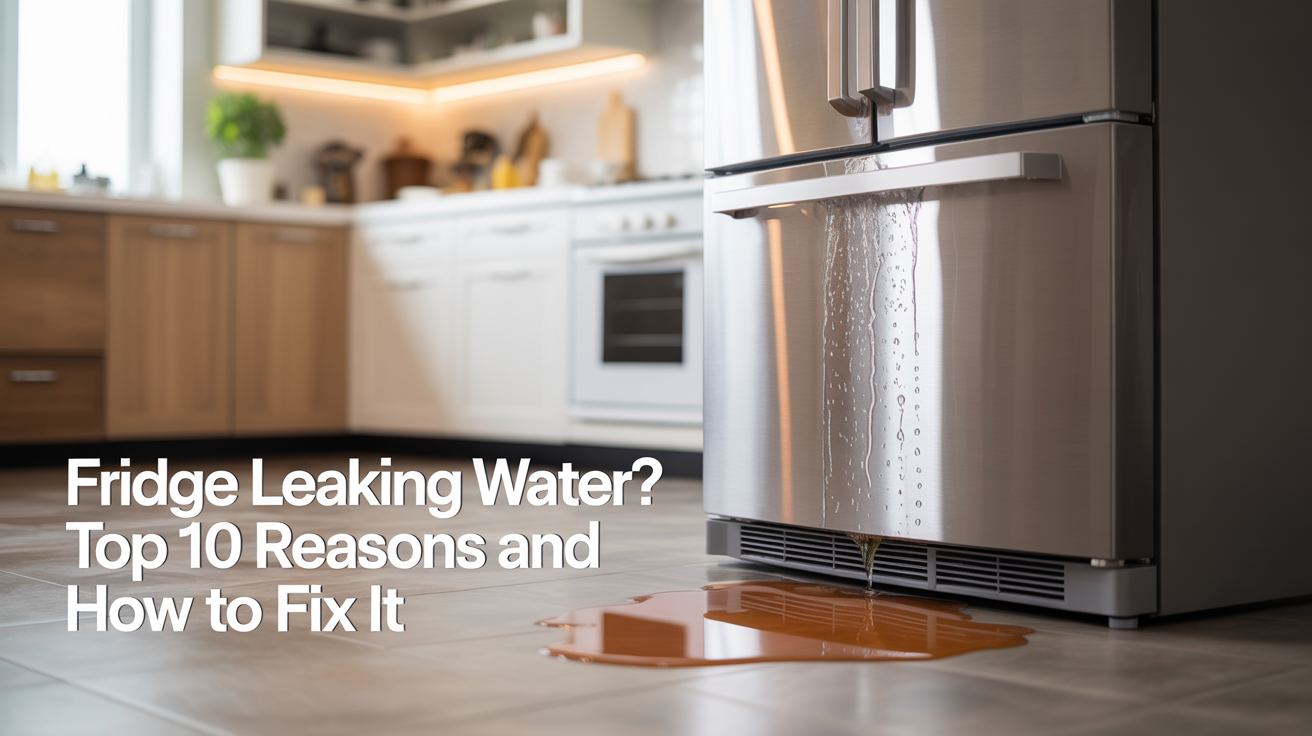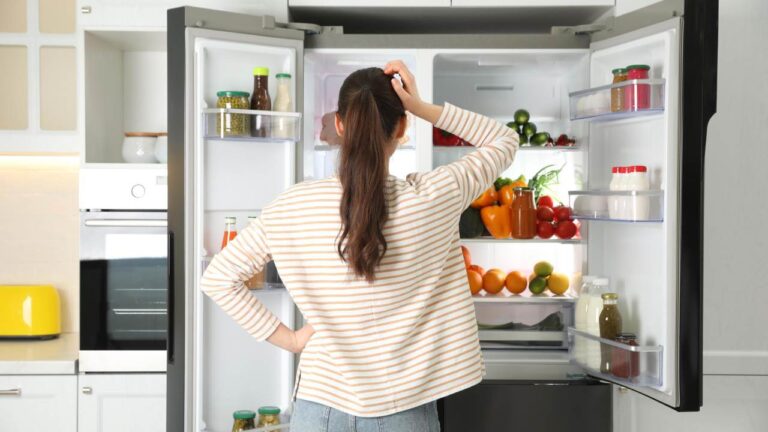Fridge Leaking Water? Top 10 Reasons & How to Fix It
Ten Top Reasons Why a Fridge Leaks Water?
- Clogged or frozen defrost drain
- Cracked or misaligned drain pan
- Blocked or leaking water supply line (ice maker/water dispenser)
- A faulty or clogged water filter
- Broken or loose door seals (causing excess condensation)
- Damaged or overflowing drip tray
- Excess humidity causes condensation buildup
- Tilted fridge (not level, water can’t drain properly)
- Ice maker malfunction or overflow
- Fridge door left open slightly (causing excess frost melt)
Unfortunately, water leakage is a common problem in residential refrigerators. A freezer discharges part of its contents into the connected fridge. When you defrost, the drain becomes clogged with dirt, creating condensation and frost regulation problems.
However, several different possible sources of refrigerator leaks exist, so it is essential to learn their warning signs and proper leak repair procedures. The guide discusses ten typical leakage triggers alongside practical methods for fast problem resolution.
What Causes Water Leaks from My Fridge?
Water leakage from your refrigerator creates stress and could harm your flooring. Seeing water accumulate might make you question whether your kitchen remains structurally sound.
Most refrigerator leaks stem from manageable problems that efficient fixes resolve quickly. Rectifying where the leak originates in your system accomplishes two critical goals, it protects your floors and restores your home to a stress-free environment.
1. Clogged or Frozen Defrost Drain
Melted frost from the defrost drain ends up in the drain pan. When food debris, ice, and other smaller particles obstruct the drain, your fridge or freezer suffers from water backup.
Solution of Clogged or Frozen Defrost Drain
Unplug your fridge and access the rear panel. Warm water combined with a turkey baster or pipe cleaner helps you complete a drain flush procedure. You should either wait for frozen areas to thaw naturally or use a hair dryer to manage the process, but with caution. Regular cleaning prevents future clogs.
2. Cracked or Misaligned Drain Pan
A drain pan collects defrost water at the bottom of the fridge. If cracked, dislodged, or warped, it can’t hold water, causing leaks underneath.
Solution of Cracked or Misaligned Drain Pan
Locate the pan behind the kick plate. Remove and inspect it. Clean out any dirt and check for damage. If cracked, replace it and ensure it’s appropriately seated to catch drainage.
3. Leaking or Blocked Water Supply Line (Ice Maker or Water Dispenser)
The water line that feeds the ice maker or dispenser can crack, clog, or become loose, causing small drips or serious leaks behind your fridge.
Solution of Leaking or Blocked Water Supply Line
Move the fridge and inspect the hose. Tighten any loose connections. The line requires replacement when it shows signs of brittleness or develops bulges or cracks. When doubt exists, a technician should inspect droplet leakage through hidden spots.
Related Article: 6 Steps to Fix a Noisy Refrigerator | Troubleshooting Guide
4. Faulty or Clogged Water Filter
Old, improperly installed, or incompatible water filters can leak due to pressure buildup or poor sealing. This often happens after a recent filter change.
Solution of a Faulty or Clogged Water Filter
Check if the filter is installed correctly and fits your fridge model. Replace it every 6 months using OEM parts. A new, properly seated filter should stop the leak.
5. Broken or Loose Door Seals (Causing Condensation)
Damaged or dirty door gaskets let warm air enter the fridge, creating excess condensation that turns into puddles or frost.
Solution of Broken or Loose Door Seals
Examine seals for any signs of breakage or holes. Test the door seal’s strength by trying to pull a sheet of paper in front of a shut door. Weak seals will let the paper slide through. Installation of a new tight-sealing gasket remains an option, but cleaning the existing gaskets to achieve a proper seal is equally acceptable.
6. Overflowing or Damaged Drip Tray
The drip tray holds water from defrost cycles. It can leak onto your floor if it overflows, clogs with debris, or cracks.
Solution of Overflowing or Damaged Drip Tray
First, disconnect the fridge from power, then clean the tray. Check for cracks or warping. Replace it if needed and ensure it’s level and properly positioned.
7. Excess Humidity Causing Condensation
When doors open in humid conditions, hot air enters, eventually condensing within the refrigerator. This moisture pools and may leak out.
Solution of Excess Humidity Causing Condensation
Limit how often and how long the door is open. Wipe visible moisture regularly. A dehumidifier paired with moisture-absorbing desiccants or moisture absorbers inside your refrigerator should be considered for use in your kitchen space.
8. Fridge Not Properly Leveled
When your refrigerator leans forward, the drainage of defrost cycle water becomes unsteady. It may pool inside or leak from the front.
Solution of Fridge Not Properly Leveled
Use a level tool. Adjust the front legs so the fridge leans slightly backward. This helps both door sealing and water drainage.
9. Ice Maker Overflow or Malfunction
A malfunctioning float mechanism or sensor in the ice maker may cause overfilling, which results in water spilling into the freezer or outside the refrigerator.
Solution of Ice Maker Overflow or Malfunction
Check the ice maker for sensor failures and ice jamming states, then disable the feature. If the problem persists, a professional must reset the control board or replace valve components.
10. Fridge Door Left Open Slightly
Leaving the door ajar causes warm air to enter, leading to frost buildup. When it melts, it creates water that pools inside or leaks out.
Solution of Fridge Door Left Open Slightly
Always ensure the door closes completely. Don’t overload the fridge, as items can push against the door. Check for obstructions and align the door if it seems crooked.

Step-by-Step Guide to Fixing a Leaky Fridge Freezer
Have you noticed water pooling under your fridge freezer? Don’t panic. The following steps will help you solve the issue like a trained professional.
Step 1. Find the Leak Source:
You can track down the water buildup inside your appliance by examining the interior of your fridge, the area under each drawer, the back panel, and the bottom of the appliance.
Step 2. Clear the Defrost Drain:
You can unclog frozen blockages or debris using a turkey baster or pipe cleaner combined with warm water.
Step 3. Level Your Fridge:
Use a spirit level to ensure it’s even. To ensure your refrigerator maintains an even position, check it with a spirit level, then adjust the feet for proper leveling.
Step 4. Inspect Door Seals:
Take a few moments to check if air escapes along the edges of your refrigerator doors. If so, replace damaged or loose gaskets.
Step 5. Check the Drain Pan:
Empty the contents of the bottom container. If the drain pan develops cracks or mold growth, throw it out and get a new one.
Step 6. Examine Water Lines:
Check the back line for leaks or damage inside your refrigerator’s integrated ice maker or dispenser system.
Step 7. Set Correct Temperatures:
Both refrigerators should maintain storage temperatures between 3–5°C for the refrigerator section and require -18°C for the freezer section.
Final Step. Call Professionals:
Contact professional help when refrigerator issues are not resolved independently.
Must Read: Your Washing Machine Smells So Bad? How to Get Rid of Them!?
Get Expert Help for Refrigerator Water Leaks
Have you tried the DIY fixes and still have a puddle under your fridge? It might be time to call in the experts. Persistent leaks often point to hidden or complex issues that require a trained eye.
Appliance Repair Dubai is a trusted name in refrigerator repair, offering specialized solutions for leaking units. Their skilled technicians are equipped to pinpoint the root cause—a clogged defrost drain, broken water line, or failing gasket—and provide long-lasting, reliable repairs. With a focus on quality service and customer care, they’ll get your appliance back to peak performance in no time.
So, call +971 552909054 now and get a free quote for refrigerator leak repair today.
Pro Tips to Prevent Fridge Leaks in the Future
Keep your appliance running smoothly and your floors dry with these six easy fridges (refrigerator) maintenance tips:
- Perform a monthly interior cleaning to avoid food accumulation and clogged drains.
- Wipe down door gaskets regularly and check for tears or looseness.
- Avoid overfilling your fridge, blocking airflow, and messing with internal temperatures.
- Leave space behind the appliance to allow proper ventilation and help prevent overheating.
- Defrost the freezer if ice builds up, especially if you don’t have a frost-free model.
- Change the water filter regularly (every 6 months) if your fridge has one.
Conclusion of Leaking Fridge Fixation
A leaking fridge doesn’t always mean major repairs—it often points to simple issues like clogged drains, faulty filters, or worn door seals. Identifying the root cause early and applying the proper fix can prevent further damage and keep your kitchen safe and dry.
If DIY methods don’t solve the problem, trust the experts at Appliance Repair Dubai for fast, reliable solutions. Call now to schedule fast, reliable fridge leak repairs with our certified technicians — we’re just a phone call away!



![How to Get Rid of a Refrigerator [ +13 Option]](https://appliancerepairdubai.ae/wp-content/uploads/2025/06/How-to-Get-Rid-of-a-Refrigerator-13-Option-768x431.webp)
